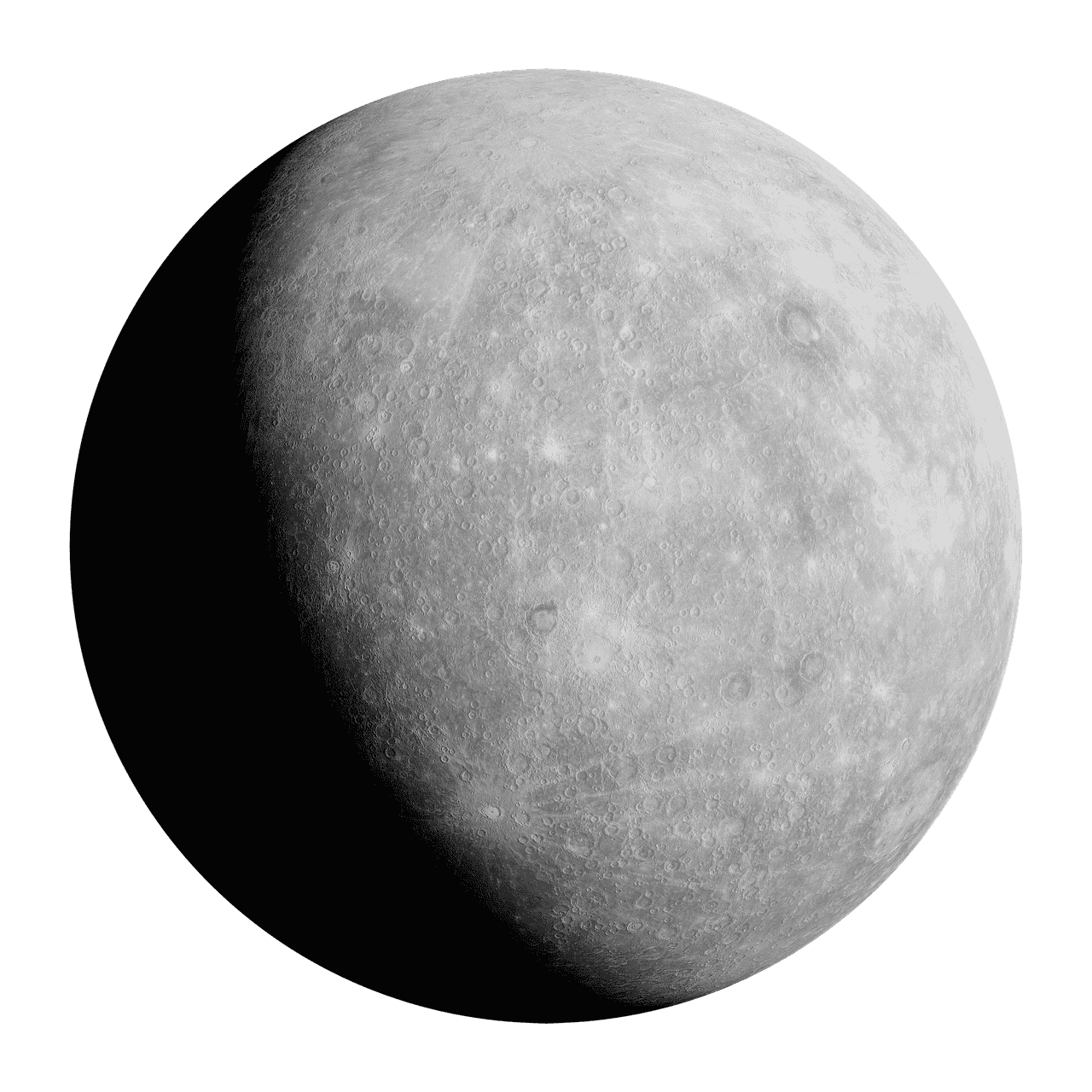Mercury
Messenger of the Gods
The smallest planet in our solar system and closest to the Sun

Composition
Iron core with a thin silicate mantle
Atmosphere
Extremely thin exosphere of oxygen, sodium, hydrogen, helium, and potassium
Cosmic Portrait
Mercury: The Smallest, Fastest, and Most Extreme Planet
The Mercury planet is the closest world to the Sun, a small but mighty member of our solar system that packs some of the most dramatic extremes in temperature, speed, and geological history. Despite its size—barely bigger than Earth’s Moon—Mercury holds secrets about the early formation of planets, the effects of solar radiation, and the resilience of rocky worlds.
Overview of the Mercury Planet
Mercury is the smallest planet in the solar system, with a diameter of just 4,880 km. It orbits the Sun in a swift 88 Earth days, earning its title as the fastest planet. Yet, its slow rotation—taking 59 Earth days to complete—creates a bizarre day-night cycle. Because of this, a single day (sunrise to sunrise) on Mercury lasts 176 Earth days, meaning its year is shorter than its day.
Structure and Composition of Mercury
When scientists look at the Mercury planet, one of its standout features is its huge metallic core. About 75–85% of its interior is iron–nickel, making it one of the densest planets in the solar system. The remaining structure includes:
- Core: Mostly iron–nickel, partially molten, generating a weak but measurable magnetic field.
- Mantle: Thin layer of silicate rock compared to other rocky planets.
- Crust: Ranges between 35–70 km thick, covered in impact craters and cliffs called lobate scarps formed by the planet’s gradual shrinking.
The oversized core is likely the result of early collisions that stripped away much of the original mantle. Over time, the cooling of the core has led to contraction, causing the surface to crack and shift.
Rotation, Orbit, and Temperature Extremes
The Mercury planet has an eccentric (oval-shaped) orbit with an eccentricity of 0.21. Its distance from the Sun varies from 46 million km at perihelion to 70 million km at aphelion. This changing distance, combined with its lack of a substantial atmosphere, produces incredible temperature fluctuations—from scorching highs of +430°C during the day to freezing lows of -180°C at night.
This lack of atmosphere also means no weather, wind, or clouds—just raw, exposed surface directly under the Sun’s glare or the cold of deep space.
Surface Features of Mercury
Mercury’s landscape is a mix of ancient craters, smooth plains, and mysterious features:
- Impact Basins: The Caloris Basin is one of the largest impact craters in the solar system, over 1,500 km across.
- Lobate Scarps: Giant cliffs formed as the planet cooled and contracted.
- Hollows: Bright, shallow depressions caused by volatile materials evaporating from the surface.
- Polar Ice: Water ice in permanently shadowed craters at the poles, confirmed by NASA’s MESSENGER mission.
Atmosphere and Magnetic Field
Mercury has no thick atmosphere, but it does have an exosphere—a thin layer of atoms ejected from its surface by solar wind and micrometeorite impacts. This exosphere contains oxygen, sodium, hydrogen, helium, and potassium. Despite its small size, Mercury maintains a magnetic field about 1% the strength of Earth’s, likely powered by the movement of molten material in its outer core.
Key Facts and Figures
| Feature | Detail |
|---|---|
| Diameter | 4,880 km |
| Orbital Period | 88 Earth days |
| Rotation Period | 59 Earth days |
| Surface Temperature | +430°C (day) to -180°C (night) |
| Core Composition | Iron–nickel, partially molten |
| Moons | None |
| Magnetic Field | ~1% of Earth's strength |
Exploration and Latest Discoveries
NASA’s MESSENGER spacecraft (2011–2015) mapped the entire surface of Mercury, discovered polar water ice, and revealed unexpected chemical compositions. The joint ESA–JAXA BepiColombo mission, launched in 2018, is set to arrive in 2025. It will deploy two orbiters: the Mercury Planetary Orbiter to study the surface and composition, and the Mercury Magnetospheric Orbiter to analyze the magnetic field and solar wind interaction. This mission is expected to answer long-standing questions about Mercury’s origin and geological activity.
Why Mercury Planet Matters
Studying Mercury isn’t just about knowing our cosmic neighbor—it’s about understanding planetary evolution. Its massive core, absence of a thick atmosphere, and exposure to intense solar radiation make it a natural laboratory for learning how rocky planets form and survive close to their stars.
Frequently Asked Questions About Mercury Planet
- Is Mercury the hottest planet?
- No. Venus is hotter due to its thick atmosphere trapping heat, even though Mercury is closer to the Sun.
- Why doesn’t Mercury have moons?
- Its proximity to the Sun means the Sun’s gravity would destabilize any moon’s orbit.
- Can humans live on Mercury?
- Not with current technology. Extreme temperatures and lack of atmosphere make it uninhabitable.
- Does Mercury have seasons?
- No, its minimal axial tilt (about 0.034 degrees) prevents significant seasonal changes.
- What’s unique about Mercury’s day?
- Its day is longer than its year—176 Earth days compared to 88 Earth days for a full orbit.
Final Thoughts
The Mercury planet might be small, but it’s a giant in terms of intrigue. With upcoming missions and advancing technology, we’re on the verge of uncovering more about this mysterious, extreme, and beautiful world. Each discovery deepens our understanding of planetary science and the dynamic forces shaping our solar system.
Fun Fact
Mercury has no atmosphere, so there's no weather - no wind, no clouds, no rain or snow!